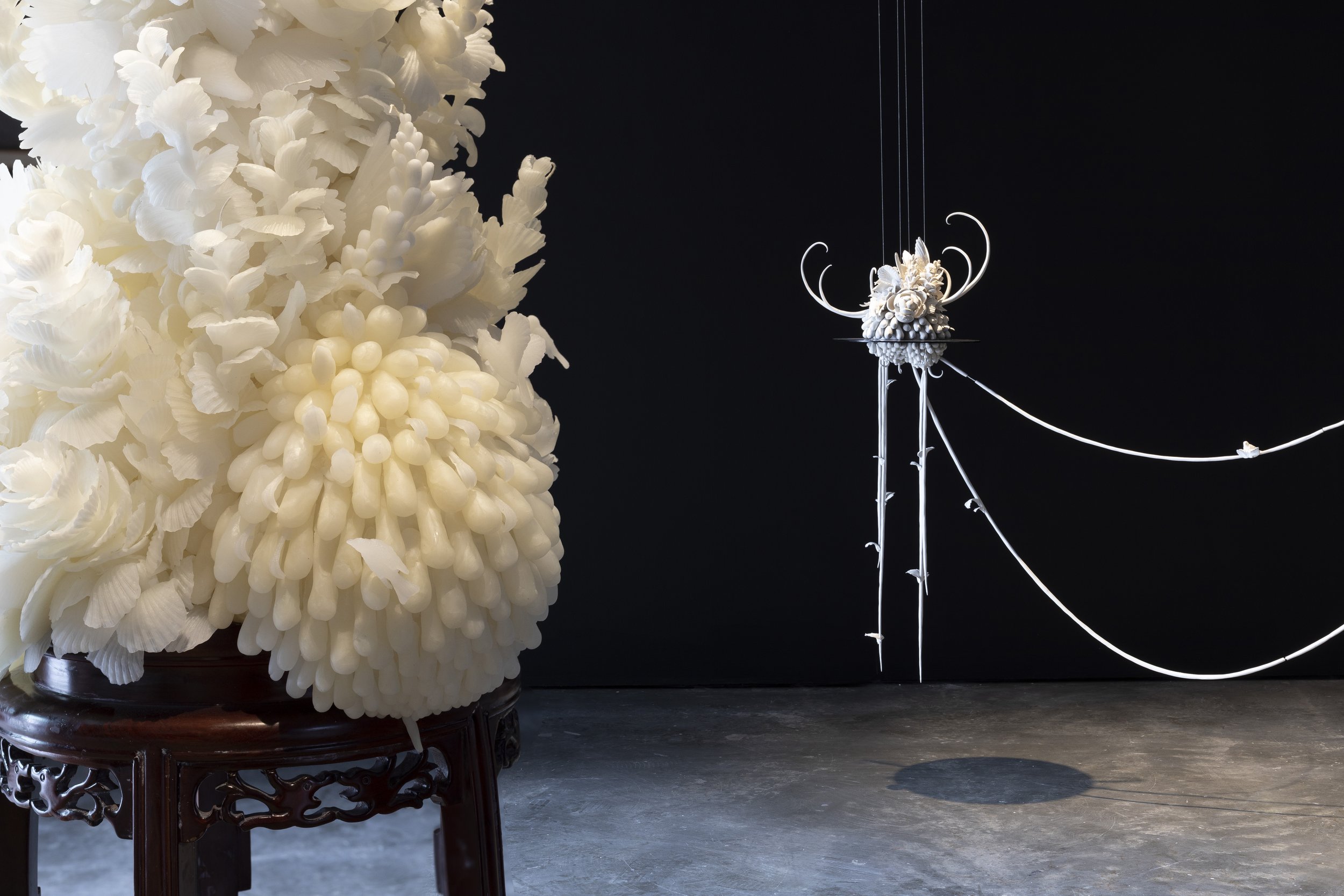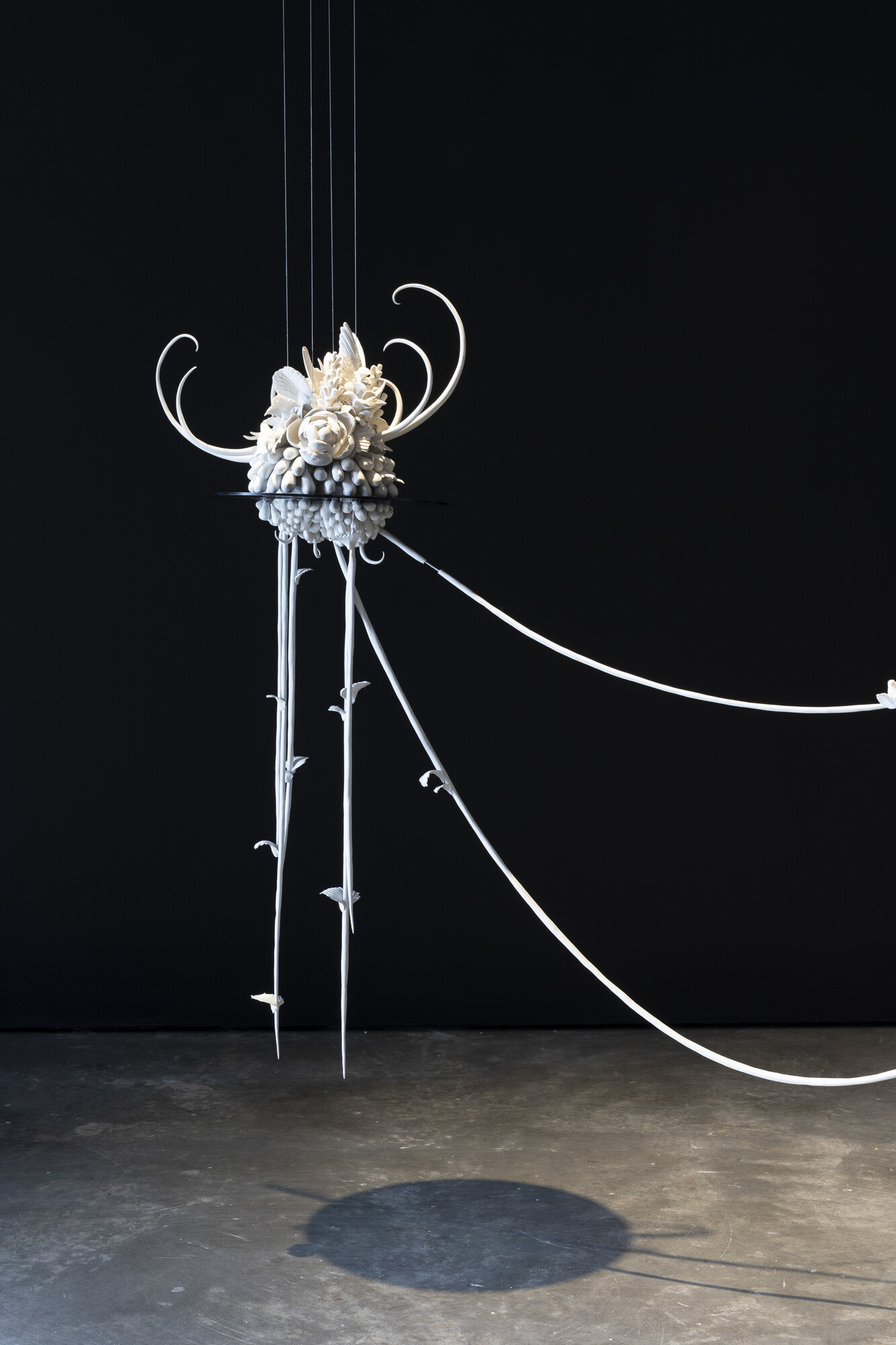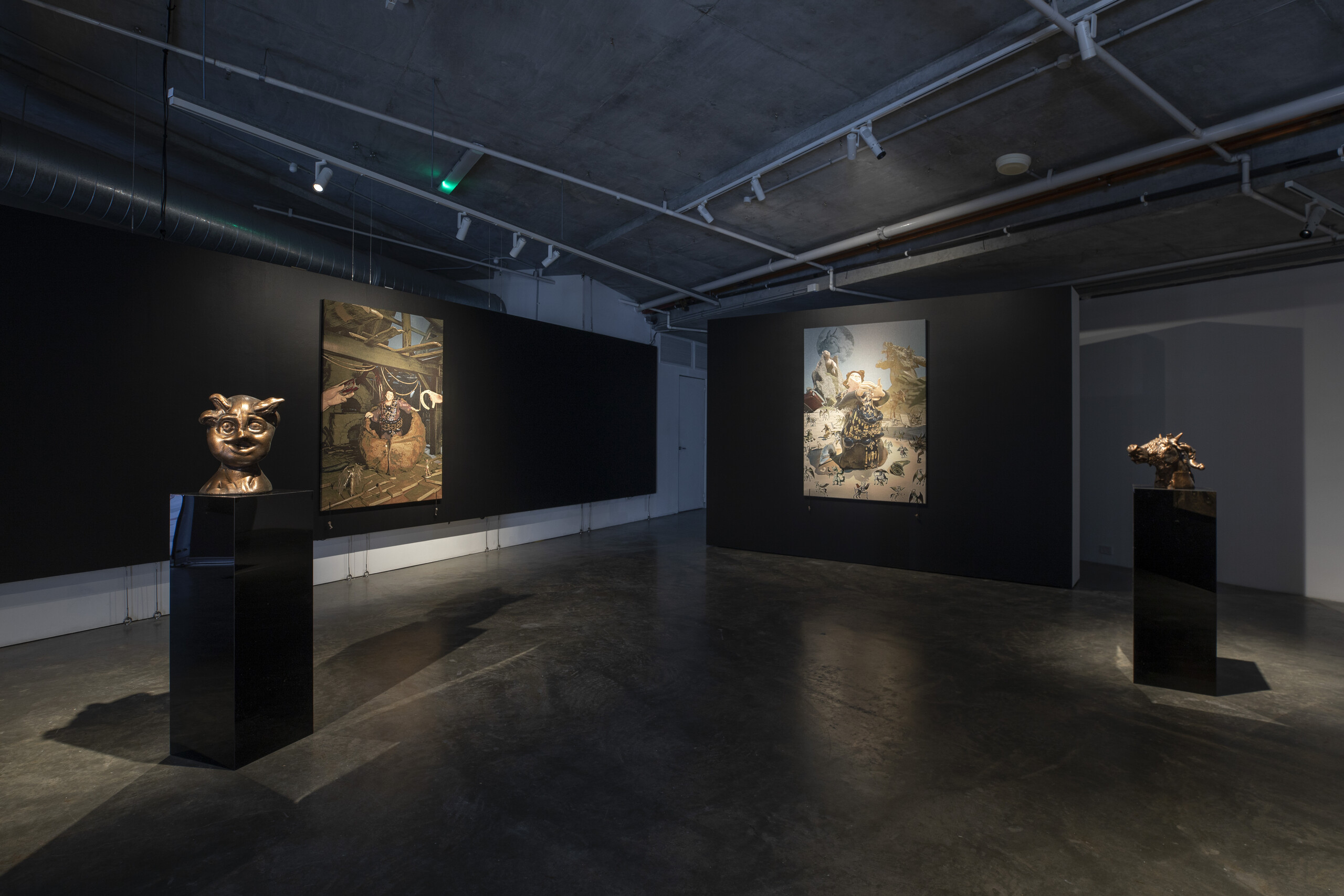Nicholas Aloisio-Shearer, Fearless Simpleton; Ruth Ju-Shih Li, Still Life of a Distant Memory
Emily Best
Ruth Ju-Shih Li’s spectral Florigelium (2023) is the haunting centrepiece of her solo show Still Life of a Distant Memory, currently on view at Verge Gallery. Described by curator Con Gerakaris as an “otherworldly bloom,” the work fuses together an assortment of native and non-native flora into a wax sculpture, creating an entirely new lifeform that is then perched on an ornate Chinese rosewood stand. It’s the intricacy of Florigelium that beckons me closer, and it’s this need to observe Li’s careful indentations into wax that reveals a significant detail: a network of wicks, almost invisible, scattered throughout the obelisk.
In an instant, Li issues her viewer with a simple warning: there is no permanence here. For all its intricacy and beauty, Florigelium was formed with a singular conclusion in mind—its destruction. The realisation hits me like a sudden loss. The sensation is amplified by the reverberating piano tones that fill the gallery space, a haunting addition from Megan Alice Clune, titled Piano for ruth (2023). Clune’s wistful composition gives gravity to the imminent decay of the sculpture (a process which began on 1 June, with the lighting of the wicks, and one that continues throughout the exhibition). Li allows the flames to feed upon the unimaginable hours of labour that the construction of the work involved. That is, she invites decay into her process. It is not a consequence that must be avoided, but rather it is a valuable contributor to the final work. Yet despite this emphasis on decay, the space doesn’t feel overly morbid. The process of viewing the exhibition instead feels precious, as though we are being granted a privileged glimpse at the works before their disintegration.

The delicacy and unguarded openness of the space has a strong impact on how I navigate the remaining works. When approaching Still Life from a Distant Memory (2020–ongoing), a nexus of flora similar to that seen in Florigelium, I feel as though I ought to hold my breath. Suspended from the ceiling, mirrored plates hold numerous botanical specimens, which sprout fronds that curl upwards. Aerial roots dotted with leaves reach down towards the concrete below, appearing petrified in a futile search for substance. Made from unfired clay, Li makes the artistic choice to leave the sculptures trapped in a state of agonising fragility, seemingly one breath away from turning to dust. Impossibly intricate, they read almost as specimens typical of a museum, only with the notable, and strangely unsettling, absence of a glass wall separating the viewer from the work. In doing so, Li relinquishes that which the institution of the museum holds sacred: control over decay, over time, and over the body of the viewer. The fine ridges and curves of the clay create a transfixing sense of texture, and the work seems to reach outwards, begging to be touched. And they can be. Li lines the experience of viewing her works with a certain tension, a responsibility that makes the fragile works feel even more delicate. Already, I notice, a tiny piece of a curled frond has snapped off.

Tucked in a corner, spouting from the junction between two walls like a stream of water, hangs a halved culm of bamboo. It bobs ever so slightly, as if breathing, when I approach. Attached to the end is another of Li’s unfired blooms, which dangles above another mirrored plate, its weight completely supported by the bamboo. Gerakaris calls Bamboo Study IV (2023) “an examination of tension and release”, with the tension beginning in the early viewing, in the impulse for preservation. This impulse aligns with institutional expectations surrounding the display of art objects, where every effort is made to freeze time by putting objects behind glass, varnishing, glazing, temperature control, keeping them away from daylight or camera flash, the use of stanchions, or the deployment of security. These are techniques directed towards making the impermanent permanent. In denying these administrative structures, Still Life from a Distant Memory creates a space where the transient body of the viewer exists on equal footing with the transient body of the works, allowing for a gentle kinship built upon mutual decay.

While Li’s sculptures offer a sense of quietness and gentle observation—a cool reprieve from the noise of City Road outside—Nicholas Aloisio-Shearer’s Fearless Simpleton, also on view at Verge, produces an abundance of visual noise. Described by the artist as a collection of “anachronistic allegories,” the show builds a grand cathedral out of the smaller of Verge’s two exhibition stages, with three large tapestries dominating the walls of the space. The works take heavy inspiration from Western art history, biblical imagery, and Sicilian folklore. Bolstered by the texture provided by the process of jacquard weaving, the works have an incredible materiality, and an air of decadence supplied by a combination of subject matter and scale.

The leftmost tapestry, The Count’s Beard (2023), features the figure of the seraphim from Sicily’s Cefalù Cathedral, a cherubic figure cloaked in a purple robe and heavy golden jewellery, frozen in place after emerging from the shell of a walnut. The gravitas of this imagery is interrupted by a hand that emerges from the left of the tapestry, dousing the central figure in a stream of Coca-Cola, poured from a giant can. The imagery collides, knocking the work out of sync with itself, a process that Aloisio-Shearer describes as “apocalyptic convergence”. We can see this convergence repeating across Aloisio-Shearer’s other tapestries in the space, which are created through 3D-rendering and filled with references to contemporary Internet folklore (Misfortune is scattered with AI-developed creatures, and The Princess With the Horns (2023) features references Berserk and The Elder Scrolls). Here opposites are forced into coexistence, creating a particle collider of mythology. The force of the impact knocks the works askew, imbuing them (and the show) with a disorienting atmosphere. Figures become uncanny through the artist’s signature rendering: faces droop, smiles are lopsided, and limbs twist uncomfortably. They feel almost unreal, there but not, floating in a plane of existence entirely of Aloisio-Shearer’s own design.

Extending beyond the three tapestries, Aloisio-Shearer brings his cacophonous allegories into the third dimension through the inclusion of two bronzed busts: Demone Asino and Donkey, Donkey, Money, Money (both 2023). As with the tapestries, both sculptures appear almost as relics from an unknown time, this time mimicking the bronze busts that appear throughout the Western art canon. Aloisio-Shearer’s busts monumentalise not “heroic” historical figures, but his own characters: a mythical combination of a donkey, dragon and pig, and a three-horned humanoid with wide, distorted eyes and a cavernous mouth. Closer inspection also reveals that the busts are made not of bronze, but of 3D-printed bioplastic, linking them back once more to the digital, and to the blend of references used to concoct the artist’s vast reality. After viewing Aloisio-Shearer’s works in PARI’s Open World in May, Fearless Simpleton feels like an extension of the artist’s unique folklore, forming a network that pushes the past, present, and future, the physical and the digital, into a singular, blinding explosion.

Still Life from a Distant Memory and Fearless Simpleton are two shows both preoccupied with memory, whether indulging in its fallibility, or drawing upon it as a resource, creating alternate realities built upon assorted canons. Li’s sculptures come alive in the warped, changing nature of recollection: her decaying monuments ultimately exist only in the memory of the viewer. It’s a powerful transfer of responsibility to the viewer, one that I feel great appreciation for. In a similar way, Aloisio-Shearer’s earthquake of a show accesses collective memories in order to shape new ones, creating allegorical worlds so vast that details are inevitably lost, but a joy to rediscover with another glance. Within Verge’s walls, the interplay of forgetting and remembering force the two opposites to become entangled, weave around one another, until they are so tightly bound that they feel like the same thing.
Emily Best is an emerging writer and artist living on Wangal land in Sydney’s inner west.


